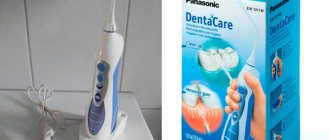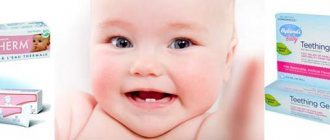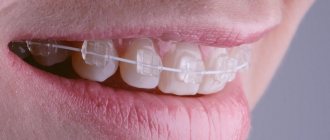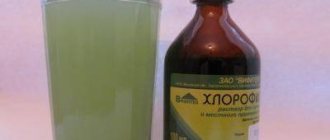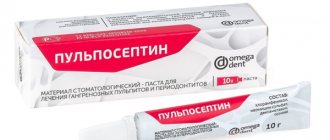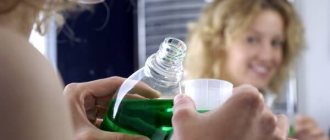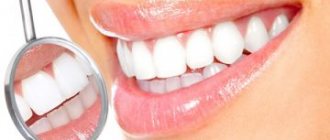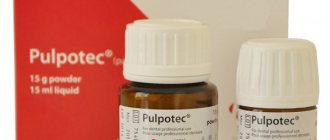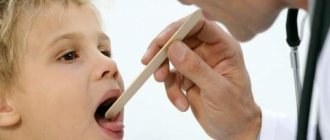Candide solution for fungal infections in the oral cavity - principle of action and instructions for use
The appearance of a dense whitish or grayish coating on the surface of the tongue, gums and cheeks usually indicates the development of a candidal infection - thrush. Often the pathological process is accompanied by the appearance of small ulcers. After examination and confirmation of the diagnosis, the dentist prescribes appropriate antimycotic drugs. One such remedy is Candide oral solution. This is an antifungal drug, and you will learn how to use it correctly from this article.
Instructions for use for infants (newborns)
Before using Candida for a newborn, be sure to consult your doctor.
Candida is prescribed to infants when a cheesy coating appears on the oral mucosa. This lesion is caused by the development of a fungus and therefore requires treatment. Otherwise, the lesion grows further, affecting the digestive organs and the genital area.
With candidal stomatitis (thrush), there is a loss of appetite, the baby becomes whiny and restless. The problem can be eliminated by local treatment with an antifungal agent based on clotrimazole.
For mild stomatitis, the child’s mucous membrane is treated with Candide solution in the following order:
- moisten a cotton pad in a weak solution of potassium permanganate and wipe the oral mucosa with it;
- Apply 3 drops of the drug to a clean cotton pad or cotton swab and use targeted movements to treat the affected areas with fungus (alternatively, wrap a bandage around your finger and apply the working solution to it).
According to the instructions, the number of procedures per day is no more than 2 times. After 2-3 days, improvements will be visually noticeable, the affected areas will decrease. It will take a week to treat a mild form of stomatitis, and more complex cases require an integrated approach with additional treatment with an alkaline solution (soda up to 5 times a day) and other antifungal agents. You cannot increase the dose of Candida or the number of daily procedures. Treatment for extensive thrush lasts up to 10-14 days.
Indications for use
An antifungal solution is prescribed for use in patients with damage to the oral mucosa and pharynx due to excessive proliferation of yeast-like fungi of the genus Candida and other types of fungi, including molds and dermatophytes. Thus, “Candide” is usually prescribed for the development of oral thrush and candidal stomatitis against the background of reduced immunity.
The drug is used in the treatment of thrush
Prevention of candidiasis
Treatment of candidiasis of the oral mucosa is effective if the patient, after recovery, follows a number of preventive measures. Decreased immunity and poor hygiene can re-ignite the disease, especially if it is chronic. To protect yourself from relapse, you need to follow a number of simple recommendations:
- high-quality and regular hygiene;
- professional removal of dental plaque (it is recommended to undergo the procedure once every six months);
- proper nutrition, moderate consumption of carbohydrates and yeast products;
- to give up smoking;
- Regular intake of vitamins, calcium and iron.
Release forms
The main form of release of “Candida” is a solution in which the concentration of the active substance is 1%. The product is sold in a 15 ml polyethylene bottle. The kit includes a dropper plug, which greatly simplifies the process of treating affected areas of the mucosa. The slightly viscous substance is colorless and odorless, but after using it, patients note a slight bitter taste in the mouth. The drug is also available in other form factors: ointment, spray, suspension, gel, powder and lotion. However, not all of the listed forms are intended for treating the oral mucosa.
In dentistry, the drug is used in the form of a solution.
Causes of candidiasis
Oral candidiasis is caused by fungi belonging to the genus Candida.
These are yeast-like single-celled microorganisms that are part of the opportunistic microflora and are found in 90% of the world's population. Most people have fungi and can live in different parts of the body: in the genitals, gastrointestinal tract, on the mucous membranes of the nasopharynx and mouth, on the skin. Fungi are called opportunistic because under normal conditions they do not show increased activity and do not cause unpleasant symptoms. But when a favorable environment is formed and the protective functions of the human body are weakened, yeast-like microorganisms are activated, begin to rapidly multiply and invade soft tissue cells, provoking manifestations of candidiasis. The following negative factors contribute to the development of thrush:
- endocrine diseases: hypothyroidism, diabetes;
- chronic gastrointestinal diseases: gastritis, esophagitis;
- pregnancy;
- lactation period;
- weakened immunity due to frequent ARVI and other infections;
- immunodeficiency states;
- HIV;
- tuberculosis;
- syphilis;
- use of braces or dentures;
- taking medications from the category of immunosuppressants that suppress the normal immune response of the human body;
- hypovitaminosis and avitaminosis, deficiency of certain minerals, vitamins, macro- and microelements (zinc, iron, vitamins E, D, group B and C);
- insufficient or poor nutrition;
- alcohol abuse;
- taking narcotic drugs;
- smoking;
- long-term use of antibacterial agents that disrupt the composition of normal microflora;
- undergoing chemical or radiation therapy for cancer;
- taking oral contraceptives;
- injury to oral tissues (due to chipped teeth, malocclusion, tartar);
- severe intoxication, poisoning;
- burns in the mouth: thermal and chemical;
- caries;
- use of inhaled corticosteroids;
- errors in everyday nutrition: excess simple carbohydrates (found in sweets, pastries, bread), consumption of sour or spicy foods (violates the integrity of the mucous membranes);
- non-compliance with standard rules of oral hygiene: poor quality teeth cleaning, irregular brushing, ignoring dental floss;
- prematurity of the child.
pharmachologic effect
The main active ingredient in the drug "Candide" is clotrimazole. It is a derivative of imidazole, a broad-spectrum active component in the treatment of fungal infections. The therapeutic effect in this case is due to the ability of clotrimazole to interfere with the synthesis of ergosterol, which is present in the membrane of fungal cells. As a result, the structure of the cell itself is deformed, and it is deprived of the ability to function normally, which leads to the destruction of microorganisms1.
Composition of the drug, mechanism of action
1 percent Candide for children consists of the main active ingredient – Clotrimazole. It helps alleviate the condition, eliminates unpleasant symptoms, and kills Candidiasis. Clotrimazole inhibits the synthesis of ergosterol, an important component of the fungal cell; without it, a hole forms in the membrane, vital substances leak out and stop accumulating. Gradually, due to damage, the number of cells decreases, reproduction stops until Candida completely disappears.
Clotrimazole is used in most antifungal medications. You can also buy Candide in the form of powder, gel, drops, tablets, and cream.
Instructions and dosages
As for how to use the drug, you need to carefully check the instructions. The solution should be applied to problem areas using a cotton ball or two. "Candide" is used to treat exclusively affected tissues - it does not need to be applied to the entire mucous membrane.
For infants with candidal stomatitis
Answering the question about at what age can Candide be used, it should be noted that the drug in the form of a solution is approved for use from a very early age, that is, for newborns. But before you start treating your baby’s oral cavity, you should definitely consult a doctor. The procedure is performed as follows:
- a cotton ball should be moistened in a weak solution of potassium permanganate and carefully wipe the mucous membrane with it,
- Apply 3 drops of solution to a new clean ball or cotton swab and spot treat the affected areas.
Frequency of treatment for infants - no more than 2 times a day.
The instructions for the drug indicate the maximum frequency of treatment for infants - no more than 2 times a day. The first results will become noticeable after 2-3 days of therapy. Treatment usually takes about a week, but if stomatitis is severe, complete recovery will take 10-14 days. Moreover, therapy should be comprehensive, with the use of other antifungal agents prescribed by a specialist.
For children from 3 years old
For children aged 3 to 18 years, the dosage and frequency of use of the solution is determined by the attending physician. First, you will have to undergo appropriate diagnostics so that a specialist can determine the type of pathogen and assess the extent of the damage. The standard single dosage for children is 2-3 drops. It is usually recommended to carry out such treatment 3 times a day after meals.
Pregnancy and lactation
While there is no confirmed clinical data on the safety of using the solution during pregnancy and lactation, this product cannot be used without a doctor’s prescription. And even if necessary, a specialist may suggest the use of Candida with increased caution only in the 2nd trimester, if the benefit outweighs the potential risk.
During pregnancy you should use the drug with caution
Adults and elderly people
The dosage for adult patients is usually 10-20 drops. It is recommended to carry out the procedure 3-4 times a day. As practice shows, a noticeable effect occurs on days 3-5 of therapy. If relief does not occur during this time, you need to visit the doctor again and, as prescribed, begin more intensive complex treatment. For elderly patients, the dosage should be adjusted by a specialist taking into account the current state of health.
“And I had candidiasis in my mouth. When they put the denture on my upper teeth, about a couple of months later I started getting thrush. Terribly unpleasant sensation, I didn’t even expect it... I can’t say that something hurts, but everything itches, there’s always this plaque, smell, and burning ulcers in my mouth. Then the doctor prescribed Candide solution to me, a normal remedy, it helped me. But it’s better not to use it so easily; it’s still worth talking to the doctor.”
Valentina V.D., from correspondence on the woman.ru forum
The dosage for adult patients is usually 10-20 drops.
The instructions indicate that it is best to treat problem areas at the same time, preferably after eating. You should first rinse your mouth thoroughly and remove any remaining food. It is also important to complete the course of therapy completely. Even if acute symptoms have passed in the first days, premature cessation of treatment can lead to relapse. In the future, it will be more difficult to combat the spread of the fungus, since microorganisms become resistant to clotrimazole. And one more important point: after treating the mucous membrane, you should refrain from eating for at least half an hour.
Instructions for use
Liquid Candide should be used strictly in the doses prescribed by the doctor or indicated in the instructions. You should not skip treatments, nor should you combine two treatments at once, doubling the amount of product.
Dosage for adults and children
To treat a child’s mouth, 2-3 drops of the product are most often prescribed, which are applied with a cotton swab to the affected areas.
The Candida solution is applied using a piece of cotton wool (a cotton swab) to the affected areas of the soft tissues of the oral cavity (not to the entire mucous membrane!). One treatment involves the use of 10-20 drops of the product.
The procedure for adults should be repeated 3-4 times a day; the therapeutic effect is noticeable on the 3-5th day after the start of use. If no improvements are noted during this period, the doctor makes an additional prescription, providing for an integrated approach to eliminating the problem.
It is advisable to carry out dental treatment of focal areas on the mucous membrane at the same time (after eating). If a positive result is noticeable in the first days after treatment, there is no need to stop the procedure; residual fungal cells may re-enter the active phase of development. Repeated exposure to clotrimazole will be less effective, as microorganisms become resistant to it. This complicates further treatment.
For children over 3 years old, the dosage and regimen of use of the Candide solution is prescribed by the doctor, based on the type of pathogen and the extent of the affected area. More often, the one-time dose for a child is 2-3 drops applied to a cotton swab, which transports the product to the hearth. Healthy areas of the oral mucosa should be bypassed. It is recommended to carry out treatment no more than 3 times a day (after meals).
Important! You should not eat food for an hour after the procedure using Candide solution.
Duration of treatment
With early diagnosis of a fungal infection, treatment with Candida quickly produces a positive effect, but in any case, the solution is used for two weeks. The antifungal agent is used systemically; if you stop treating the affected areas of the oral mucosa before the specified period, the fungus becomes resistant to the active component of the drug , which reduces its pharmacological effects upon repeated use.
Stomatitis in a weak form of development does not require long-term treatment, so more often the doctor prescribes Candida in solution for use throughout the week.
How long does therapy last?
According to reviews of experts in the field of dentistry, with early diagnosis of a fungal infection, the use of the solution gives a rapid therapeutic effect, which can most often be noticed already on the 3-4th day from the start of use. However, for adult patients, the duration of therapy is usually at least 2 weeks.
As mentioned above, this antifungal agent is intended for systemic use. This means that premature cessation of its use in the future will seriously complicate the treatment process. In this case, mild stomatitis can be cured in a week, but only a doctor can determine the exact timing of treatment.
What are the contraindications
There are no categorical contraindications to the use of the solution, but before starting a therapeutic course, you should definitely consult a doctor and study the composition in order to exclude the possibility of developing allergic reactions to the components. You should also avoid using Candida during pregnancy and breastfeeding. The advisability of using the drug during these periods remains at the discretion of the treating specialist.
Before using the drug, you should definitely consult with your doctor.
Contraindications
There are no significant restrictions on the use of Candide, however, before use you should familiarize yourself with the composition to exclude an allergic reaction to the components it contains. The drug is also contraindicated:
- during pregnancy in the first trimester (active substances may have a negative effect on fetal development);
- during breastfeeding.
When consulting with a doctor, you need to inform him about your existing allergies, their causative agents, and pregnancy. The limited period of gestation in the first trimester may be accompanied by a complete refusal to take Candida. The specialist, having studied the tests and information about the course of pregnancy, weighs all the risks and threats from the use of clotrimazole.
Side effects
In extremely rare cases, the drug provokes the appearance of adverse reactions, mainly associated with the body’s increased sensitivity to the active substances included in its composition. In this case, the mucous membrane may noticeably redden at the site of application of the drops; in other situations, urticaria appears, and a slight tingling and burning sensation occurs within the treated area.
If such symptoms appear, you should rinse your mouth and consult a doctor. A specialist can suggest alternative medications to combat fungal infections. It should also be noted that a slight bitter taste in the mouth causes gagging in some patients. If a significant amount of the product enters the stomach, diarrhea and abdominal cramps may develop.
Drug interactions
Advanced forms of fungal infections require complex treatment. However, interactions with certain medications may affect the effectiveness of Candida. For example, in combination with Nystatin and Amphotericin, the activity of clotrimazole is noticeably reduced.
Interactions with certain medications may affect the effectiveness of the drug
Contraindications for the treatment of candidiasis
Although Candida solution for thrush in newborns is prescribed with high frequency, consulting a doctor will be useful. Not every child will benefit from the drug; an allergic response may occur, accompanied by Quincke's edema or more negative manifestations - anaphylactic shock. With the help of an examination, anamnesis, and consultation, the doctor will be able to determine whether the drug is dangerous for the child.
In addition, the solution should not be applied to areas:
- With wounds;
- With sores.
If you give your child Nystatin, Amphotericin B or Natamycin, then there is no point in being treated with Candida, these substances reduce the effectiveness of Clotrimazole several times. It is advisable to replace it with another medicine or abandon Nystatin, Amphotericin B, Natamycin.
Analogs of Candide
There are other means with a similar effect. So, for example, among analogues of “Candida”, experts in the field of dentistry identify the following drugs with an identical active ingredient in their composition:
- "Canesten" - presented in the form of a spray, the cost of a 30 ml bottle is approximately 350 rubles,
- “Clotrimazole” is a 1% solution with the same active ingredient in its composition, the cost of a 15 ml bottle is approximately 180 rubles,
- “Kanizon” is a cream with a 1% concentration of clotrimazole in its composition, a 20 g tube costs about 75-80 rubles,
- “Candibene” - a cream with a concentration of 1% costs around 130 rubles for a 30 g tube.
Together with Candide, the same pharmacological group also includes such products as Miconazole cream and Mycoseptin ointment. Micogal cream and Binafin oral tablets have pronounced antifungal properties. All of the above drugs are allowed for use only as prescribed by a doctor.
How much does the drug cost?
The cost of Candide depends on the form of its release and the pricing policy of the retailer. The price for a bottle of solution for treating the oral mucosa (15 ml) is approximately 350-400 rubles in Moscow pharmacies.
Candide solution is an effective remedy, which often becomes the best option in terms of price and quality ratio. The drug is non-toxic and does not cause dangerous reactions even if the recommended dosage is exceeded. At the same time, it demonstrates high efficiency in the fight against fungal infections of oral tissues, which is confirmed by numerous positive reviews from doctors and their patients.
1According to data at the office. manufacturer's website: glenmark-pharma.ru.
Thrush in the mouth: symptoms
When oral thrush occurs in adults, the symptoms can vary greatly from patient to patient. The fact is that oral thrush (oral candidiasis) comes in four main types, each of which has its own characteristic symptoms. There are the following 4 main forms of this disease:
- acute pseudomembranous candidiasis,
- acute atrophic candidiasis,
- chronic atrophic candidiasis,
- chronic hyperplastic candidiasis.
Below we will analyze the features of each form, but despite the differences in symptoms, their treatment will be carried out almost the same.
Acute pseudomembranous candidiasis –
This form of oral thrush is usually asymptomatic. There may only be discomfort due to the presence of white films or plaques rising above the oral mucosa (Fig. 4-6). With a mild course, the plaques are single, easily removed by scraping, and in this case a bright red mucous membrane is found underneath them.
In severe cases, the plaques, increasing in size, merge with each other, which leads to damage to almost the entire mucous membrane. When plaques thicken, they become very difficult to scrape off. This type of candidiasis often develops in infants, in patients after taking antibiotics, corticosteroids or immunosuppressants, in patients with an impaired immune status (due to leukemia, HIV).
Pseudomembranous candidiasis (Fig. 7-9) –
Acute and chronic atrophic candidiasis –
In acute atrophic candidiasis, the patient may feel as if the mouth has been scalded by hot liquid. At the same time, there is no white coating or plaques, and the mucous membrane is bright red. Another possible symptom is a metallic, acidic, salty or bitter taste in the mouth, as well as dry mouth. Most often, acute atrophic candidiasis develops after taking antibiotics or corticosteroids.
With chronic atrophic candidiasis, redness of the mucous membrane and a burning sensation are also observed. Most often, this form of oral thrush occurs in patients with removable dentures, and therefore it is sometimes also called denture stomatitis.
What does atrophic candidiasis look like (Fig. 7-9) –
Chronic hyperplastic candidiasis –
It occurs mainly only in adults and is quite rare (in relation to other forms of candidiasis, the frequency of its occurrence is no more than 5%). Most often it occurs on the mucous membrane of the cheeks, near the corners of the mouth, on the back of the tongue, and also on the soft palate. It is characterized by the appearance of white plaques that grow and merge over time. At an advanced stage, the surface of the plaques becomes rough and knotty. The plaques may become yellowish over time.
Important: most types of oral candidiasis are painless, and are manifested only by the presence of lesions on the oral mucosa; sometimes a burning sensation may be present. This is why candidiasis can sometimes be misdiagnosed as “burning syndrome.”
To make a correct diagnosis, it is very important to conduct a cytological examination of plaque taken from the oral mucosa. This is all the more important because very often, an abundant accumulation of non-fungal microflora (especially on the tongue) can resemble a fungal infection of the mucous membrane.
